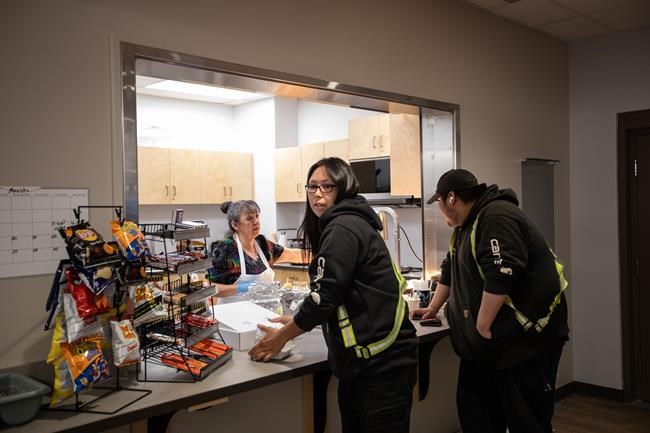
FORT MCMURRAY, Alta. — Some Indigenous communities in northern Alberta hope the Trans Mountain pipeline expansion willmark the start of a new chapter in their relationship with Canada’s oilsands industry. The$34 billion pipeline project from Alberta to the B.C. coast promises improved access to export markets for oilsands producers, which are forecast to achieve all-time-high output this year. The pipeline’s expected opening on May 1 is a big deal for the Fort McKay First Nation, located about an hour’s drive north of Fort McMurray and home to around 800 people of Dene, Cree and Métis descent. “It matters to the Fort McKay First Nation. When there’s an opportunity like the Trans Mountain pipeline, the question is, how can we actually leverage it to transfer that opportunity to Fort McKay?” said Chief Raymond Powder in an interview. “Because I’ve shared that with my industry partners across the table from time to time — I’ve said, ‘You know, if you guys want to grow and want to expand and all that, that’s not an issue for us.'” But Fort McKay also needs opportunities for growth as the industry expands, he said. Located smack-dab in the middle of the Athabasca oilsands, Fort McKay is the bull’s-eye on the dart board of the world’s third-largest crude oil reserve. The First Nations community is surrounded by industrial development, and the acrid scent of nearby oilsands facilities can be detected on the breeze. Band members like to point out the black, tarry-smelling soil that lines residents’ roads and driveways here — evidence of the rich bitumen deposits that lie so close to the surface. In Fort McKay, the complicated relationship that the oilsands industry has with Indigenous people is evident. The First Nation is one of the wealthiest in the country, thanks to revenue generated from impact benefit agreements with oilsands developers as well as from the many Nation-owned businesses that serve the oil and gas sector. Because of these spinoff benefits, the community boasts a beautiful long-term care centre that fronts onto the Athabasca River, a first-class arena, a virtual golf facility and other amenities not commonly found on reserves. But Powder is quick to point out that his community’s relationship with industry has not always been so rosy. “When you go back to the history of who Fort McKay is, we actually did not initially begin with a good relationship with industry because of the fact that who we are as First Nations and our identity was tied to the land,” he said. Fort McKay also has significant current concerns about the safety and environmental impact of the massive oilsands wastewater tailings ponds in the area. “And so the arrival of industry had a huge impact on our own traditional livelihood and way of life,” said Powder. “But on the positive side of all of that, we’ve had the opportunity to grow our programs, grow our services, grow our infrastructure.” Not all First Nations see their industrial neighbours this way. Eriel Deranger is a member of the Athabasca Chipewyan First Nation, which is currently suing the Alberta Energy Regulator in the wake of a series of toxic tailings ponds leaks from Imperial Oil’s Kearl oilsands facility. She’s also the executive director of Indigenous Climate Action, an advocacy group focused on the water, air, and health impacts of the oilsands on First Nations communities. Deranger describes the relationship between Indigenous communities and the oilsands industry as an “economic hostage situation,” explaining that many communities see the negative impacts of oilsands development but don’t speak up because there are no other economic opportunities to be had. “It’s really important that we don’t get bogged down in the argument of, ‘Well, if Indigenous peoples are business partners in pushing these projects forward, then they must be OK,'” Deranger said. “The problem is that this industry has such a stranglehold economically. But we cannot continue to say we need this for our economy, because there will be no economy if our province burns down this summer because of wildfires due to climate change.” Oilsands development has been a double-edged sword for Indigenous communities in the past, said Justin Bourque, the former CEO of the Willow Lake Métis Nation and president of Fort McMurray-based Âsokan Generational Developments, a consulting firm that specializes in Indigenous-industry partnerships. “Philosophically, the resource has been extracted from the traditional territories of the Indigenous peoples in the area. They have lived and endured the development, both environmentally and physically and as well with the growth of Fort McMurray,” Bourque said. But as he looks to the future, Bourque sees growing opportunities for First Nations to participate in the oil and gas sector as equity ownership models become more common, allowing communities to benefit from long-term, predictable sources of revenue. “I think now with reconciliation and certain ESG factors, corporations are now thinking more openly about sharing a long-term relationship with Indigenous communities when and where they operate,” Bourque said. He also pointed to the federal government’s recent announcement that it will offer $5 billion in loan guarantees to support Indigenous communities seeking ownership stakes in natural resource and energy projects. “I think it’s going to be a hugely positive catalyst to allow these communities to become much more active in the industry, which will only make the industry stronger.” Last month, the Fort McKay First Nation struck a memorandum of understanding with Suncor Energy Inc. on an oilsands lease development opportunity on its reserve lands. While Suncor is still assessing the quantity and quality of minable bitumen in the area, if the project goes ahead, it would be the first-ever oilsands production on reserve lands in Canada. Powder said the agreement charts a new path for economic development on Indigenous lands and will help secure the community’s long-term future. “It’s quite a huge deal and it’s actually a great accomplishment,” Powder said, adding the deal will mean that if the oilsands industry grows in the years to come, Fort McKay will grow with it. “We don’t want any ceiling on opportunities for Fort McKay when it comes to industry and the spinoffs of what that Trans Mountain pipeline has to offer,” he said. This report by The Canadian Press was first published April 29, 2024. Companies in this story: (TSX:SU) Amanda Stephenson, The Canadian Press
Share This:


